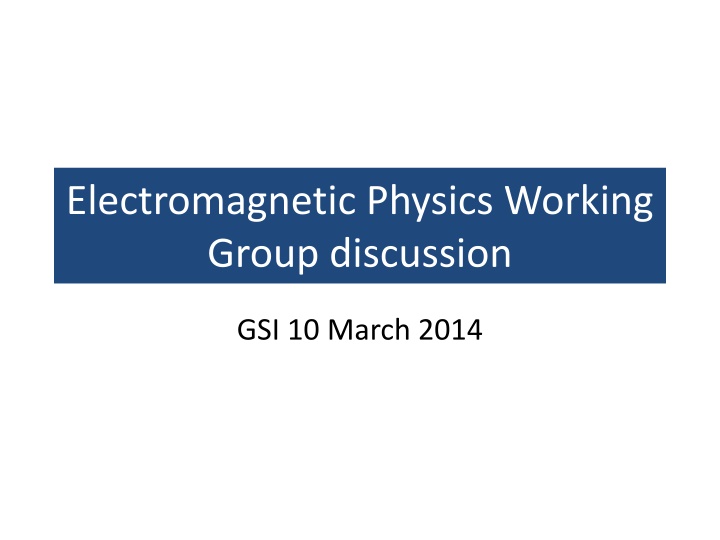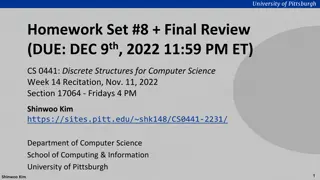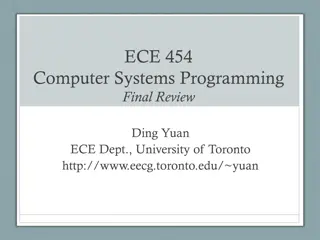
Electromagnetic Physics Working Group Discussion at GSI March 2014
Explore the challenges and goals of studying electromagnetic channels in the initial phase of PANDA, assessing consequences for different scenarios, and identifying minimum requirements for measurements. Discuss issues with low rates, reduction in luminosity, acceptance limits, and strategies for rejecting pionic background to enhance sensitivity.
Download Presentation

Please find below an Image/Link to download the presentation.
The content on the website is provided AS IS for your information and personal use only. It may not be sold, licensed, or shared on other websites without obtaining consent from the author. If you encounter any issues during the download, it is possible that the publisher has removed the file from their server.
You are allowed to download the files provided on this website for personal or commercial use, subject to the condition that they are used lawfully. All files are the property of their respective owners.
The content on the website is provided AS IS for your information and personal use only. It may not be sold, licensed, or shared on other websites without obtaining consent from the author.
E N D
Presentation Transcript
Electromagnetic Physics Working Group discussion GSI 10 March 2014
Topics of the discussion Which electromagnetic channels can be studied in the initial phase of PANDA? But what is the initial phase ? reduced luminosity (L=1/10* L max= 2 1031cm-2s-1) 4 months 0.2 fb-1 reduced detector acceptance and performance, missing subdetectors to fulfill money constraints not yet clear how such a detector will look like One possible (maybe the least bad) scenario: 6/16 EMC slices (opposite in radial direction), fully equipped with DIRC, no FW spectrometer
Goal of the discussion Start to identify what are the consequences for each channel of different scenarios Alternatively list the minimum requirements for some channels to be measured in the initial phase Summary to be presented on Friday By no means, we can give at this stage recommandations or draw conclusions Just present facts and identify which kind of simulations are needed
Simple facts, to start the discussion (I) Main challenge for electromagnetic channels Rates are very low and decrease very fast with energy e.g. pp e+e- =0.6 nb at p=1.7 GeV/c, 10 -30 fb at p=13.4 GeV/c pp (~50% larger than e+e-), pp (150x larger) pp e+e- T=1 GeV = 80 pb for q2=2 0.25 (GeV/c)2 pp J/ = 150 pb pp l+l- X = 0.8 nb 1.5 GeV/c2 < Mll< 2.5 GeV/c2 - - - - - detection of , e+e- or + - in a huge (typically 106 larger ) hadronic background : problems with misidentification of + - as e+e- or + - Misidentification of (2 ) as 1 4
Simple facts, to start the discussion (II) Reduction of luminosity and acceptance limits the energy range where sensitive measurements can be done : see examples in Thierry s talk Reduced PANDA sensitivity = 2 pb 100 evts/month at 100% efficiency (nb) PANDA sensitivity =0.2 pb 100 evts/month at 100% efficiency
Rejection of pionic background e+/e- case DIRC(Cerenkov) Straw Tube Tracker ElectroMagneticCalorimeter - A Edep/p ~ 1 A* 2 Non-gaussian tails of truncated dE/dx distribution High precision needed for dE/dx DIRC Cerenkov angle (for p<0.8 GeV/c) EMC energy resolution 4-momentum resolution Use complementarity of e/ discrimination capability of the different detectors Bayesian PID method R. Kunne Single pion rejection >3000 Global electron efficiency >60% Here, we do not want to loose anything Use kinematic fit for the given exclusive channel 6 6
More remarks about detectors for / discrimination: STT(tracking )+ EMC (acts just as a pion absorber) + Muon detector (tracking) For / discrimination, EMC granularity and resolution are essential For all channels: role of FW Spectrometer to be studied (not present in simulations up to now) essential for form factors at T>10 GeV only Which dynamics? For form factors, pe or p >500 MeV/c low energy /electron resolution probably not essential for us
What kind of simulations are needed? fast simulations with acceptance and efficiency matrices, and smearing of particle 4-momenta with parametrized resolution ? GEANT needs to be run only to calculate the matrices For which channels and which detector scenarios ?
physics channels for the initial phase? Electromagnetic channels will be fully exploited with full luminosity and detector coverage We want to achieve these conditions in a not too far future High luminosity will not come in the initial phase: the measurement at the largest energies will anyway be delayed For 2-body channels, the luminosity reduction has more effect than the 6/16 option acceptance reduction For 3 and more body channels, incomplete detector adds further limitation -
physics channels for the initial phase? form factors: pp e+e- can still be measured for q2< 9 GeV/c in 6/16 scenario. Problem of competition with BES (e+e- pp), but PANDA can measure in addition pp + - : same case (but severe background issue) pp can be measured at BELLE,BES All others channels: , e+e- can only be measured by PANDA and are very poorly known. No factorization in the low energy regime, but these channels are still very interesting for soft reaction mechanisms and to investigate nucleon form factors below threshold Focus on two_body channels at the lowest energies ? - - - - - Measurement of background hadronic reactions + - , + - , ..will be very important for the preparation of electromagnetic channel measurements.



















